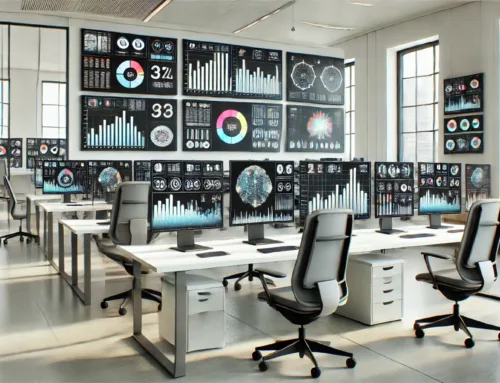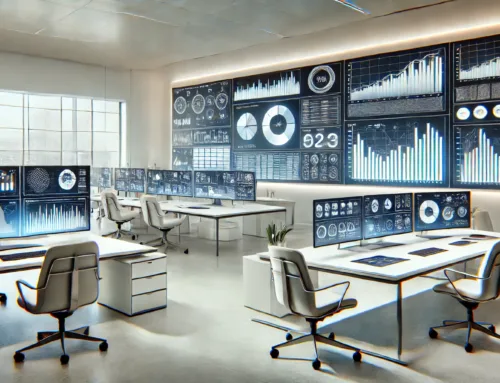To work with a data visualization agency, ensuring a smooth collaboration requires attention to detail and effective communication from both parties. Setting the foundation with a comprehensive project scope and defined goals is just the beginning. As you navigate the intricacies of working with a specialized agency, understanding how to leverage their expertise while aligning with your vision can be a balancing act. Stay tuned to discover the nuances of fostering a productive relationship that yields impactful visualizations and data-driven insights.
Define Project Scope
When working with a data visualization agency, the initial step is to clearly define the project scope. Scope definition is crucial as it sets the boundaries for the project, outlining what will be included and excluded. Clearly defining the project scope helps prevent scope creep, ensuring that the project stays on track and within the agreed-upon parameters.
To define the project scope effectively, start by outlining the project objectives and deliverables. Clearly articulate what you aim to achieve with the data visualization project and what end results you expect. Identify the key stakeholders involved and gather their input to ensure all perspectives are considered in defining the project scope.
Establish the project boundaries by specifying the limitations and constraints that will impact the project. This could include factors such as budget, timeline, resources, and technical requirements. By setting clear project boundaries from the outset, you create a solid foundation for successful collaboration with the data visualization agency.
Set Clear Goals
Setting clear goals is a critical component of any data visualization project. Goal alignment ensures that all stakeholders are on the same page regarding the project’s objectives. When setting goals, consider how data interpretation will drive decision-making and what outcomes you aim to achieve. Clearly outlining these objectives will guide the visualization strategy and help measure the success of the project.
To set clear goals, start by identifying key performance indicators (KPIs) that align with your business objectives. These KPIs will inform the type of data that needs to be visualized and how it should be presented. Consider the audience who will be interpreting the data visualizations and tailor the goals to meet their needs. By defining measurable outcomes, you can track the effectiveness of the visualizations in conveying the intended message.
Communicate Requirements
When working with a data visualization agency, it is crucial to communicate your project goals clearly and concisely. Detailing your data specifications is essential to ensure that the agency understands the intricacies of your requirements. By clearly outlining these elements, you set the foundation for a successful collaboration that meets your needs.
Clear Project Goals
To ensure a successful partnership with a data visualization agency, it is essential to establish clear project goals from the outset. Goal alignment is crucial to ensure that both your organization and the agency are on the same page regarding the desired outcomes. Clearly defining what data insights you aim to derive and the key objectives of the project will help guide the visualization strategy that the agency will develop. By outlining the project outcomes you expect to achieve, such as improved decision-making processes or enhanced data communication, you provide the agency with a clear direction to work towards. This clarity not only streamlines the visualization process but also ensures that the final deliverables meet your expectations. Effective communication of project goals sets the foundation for a productive collaboration and helps avoid misunderstandings or misalignment down the line.
Detailed Data Specifications
As you delve into the collaboration with a data visualization agency, it becomes imperative to articulate detailed data specifications to effectively communicate your requirements. Data accuracy is pivotal in ensuring that the insights derived from the visualizations are reliable and trustworthy. Clearly define the sources of your data, the level of precision required, and any specific data cleaning or processing steps that need to be undertaken.
Moreover, when outlining your detailed data specifications, consider the visualization techniques that will be employed. Communicate the specific types of charts, graphs, or interactive elements that you envision for displaying the data. Provide guidelines on color schemes, labeling conventions, and any interactive features that should be incorporated. By detailing these aspects, you provide the agency with a clear roadmap for transforming raw data into impactful visual representations that effectively convey the intended message. Clarity in data specifications will streamline the visualization process and ensure that the final outputs align with your expectations.
Provide Necessary Data
Working with a data visualization agency requires providing the necessary data to ensure the success of your project. Data preparation is crucial in this process. Start by organizing and cleaning your data to ensure its accuracy and consistency. This step lays the foundation for creating meaningful visualizations that accurately represent your insights. When providing data to the agency, make sure to include all relevant information needed for the project. This may include raw data files, data dictionaries, and any specific requirements or constraints that should be considered during the visualization process.
Data insights are also essential for the agency to understand the story behind the data. Providing context and background information about the data will help the agency create visualizations that effectively communicate your message. Be prepared to discuss the key insights you have derived from the data and any specific trends or patterns you want to highlight. By providing comprehensive data and insights, you set the stage for a successful collaboration with the data visualization agency.
Discuss Project Timeline
When working with a data visualization agency, discussing the project timeline is crucial. Setting realistic deadlines ensures that expectations are met and progress is steady. Monitoring progress effectively helps in staying on track and making necessary adjustments along the way.
Setting Realistic Deadlines
Collaborating with a data visualization agency involves a crucial aspect: setting realistic deadlines for the project timeline. Managing expectations is key when establishing these deadlines. To ensure success, consider the scope of the project, the complexity of the data, and the resources available. Being realistic about the time required for each stage of the data visualization process will help in setting achievable milestones.
Flexibility is also essential when setting deadlines. Unexpected challenges may arise during the project, leading to delays. By building in some buffer time in the timeline, you can account for these potential setbacks without causing major disruptions. Communication strategies play a vital role in this aspect. Regular check-ins with the data visualization agency can help in tracking progress and addressing any issues promptly.
Ultimately, when setting realistic deadlines for a data visualization project, a balance between ambition and practicality is crucial. By managing expectations, being flexible, and maintaining open communication, you can create a project timeline that sets the foundation for a successful collaboration with the data visualization agency.
Monitoring Progress Effectively
To effectively monitor progress during a data visualization project, maintaining a detailed project timeline is essential. Progress tracking becomes more manageable when you establish clear project milestones within this timeline. These milestones serve as checkpoints for measuring progress and ensuring that the project is on track. Communication strategies play a crucial role in monitoring progress effectively. Regular check-ins with the data visualization agency can provide insights into the progress made, challenges faced, and adjustments needed.
Review Initial Concepts
As you delve into the process of reviewing initial concepts with a data visualization agency, it is crucial to maintain a critical eye and a strategic mindset. When assessing the visual design of the concepts presented, focus on elements such as clarity, coherence, and alignment with your brand identity. Pay attention to how effectively the data is communicated through the visual elements and whether the design enhances understanding.
Provide detailed concept feedback to the agency, highlighting what works well and areas that may need improvement. Offer specific suggestions for enhancements, keeping in mind the objectives of the project and the target audience. Ensure that the feedback is constructive and actionable, guiding the agency towards refining the concepts to better meet your requirements.
Frequently Asked Questions
Can the Agency Help With Data Collection?
Yes, the agency can assist with data collection, ensuring the accuracy and completeness of your dataset. This foundational step is crucial for effective data analysis and visualisation techniques that will uncover valuable insights for your business.
How Often Will Progress Updates Be Provided?
You can expect timeline expectations to be outlined clearly. Feedback frequency will be regular to ensure alignment with project milestones. A communication schedule will be established upfront to keep you informed throughout the data visualization process.
What Level of Customization Is Possible?
When working with a data visualization agency, you can achieve a high level of customization. Interactive features allow for dynamic exploration, while color schemes enhance visual impact. Your data stories can be tailored to reflect your brand uniquely.
Are Revisions Included in the Project Cost?
Revisions policy varies among agencies. Some include a set number in the project cost, while others charge extra. Understand the cost implications upfront to manage expectations and budget effectively. Clarify revision terms before committing.
Is Training on Using the Visualizations Provided?
When it comes to training on using the visualizations provided, ensure effectiveness by incorporating interactive features. Engage users through hands-on practice sessions to maximize learning. Remember, a skilled navigator can unlock the full potential of data insights.




